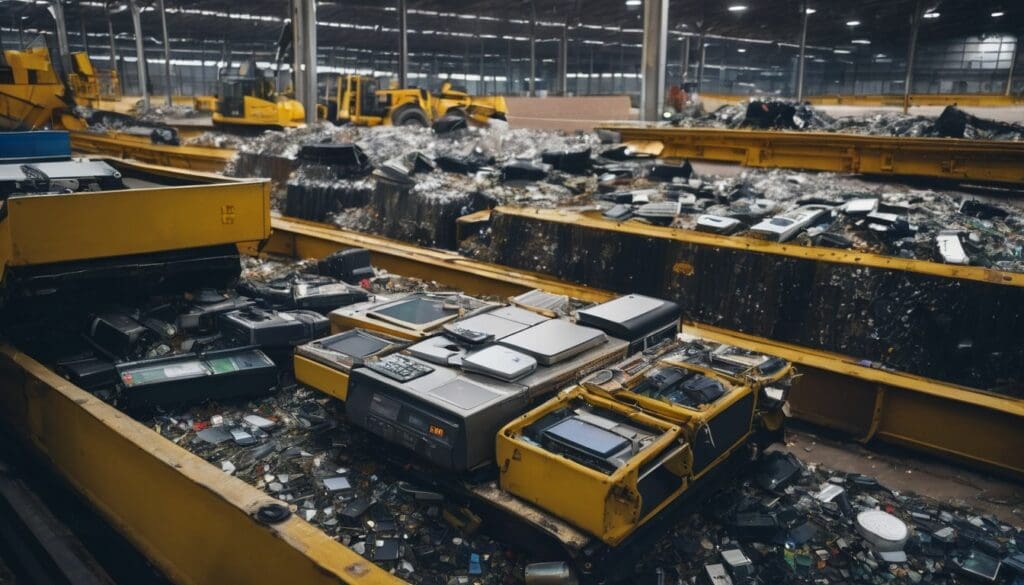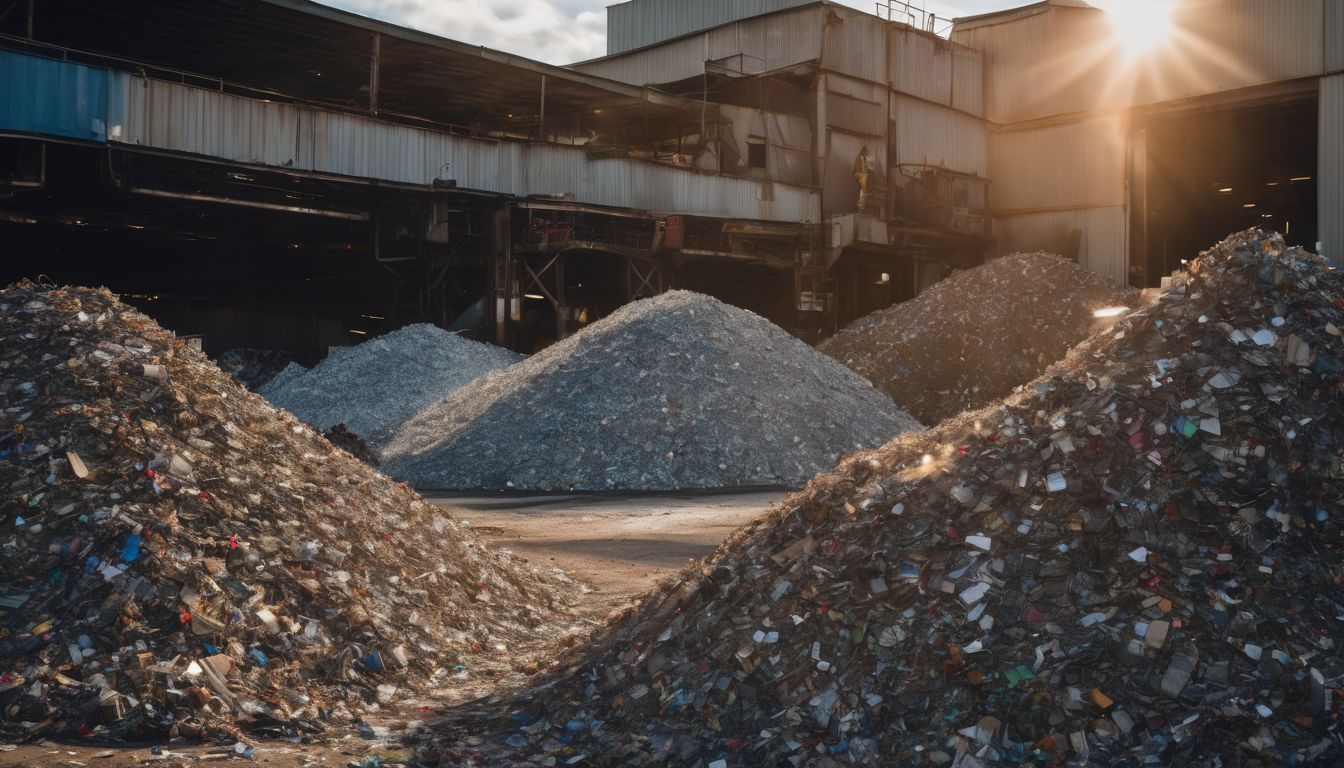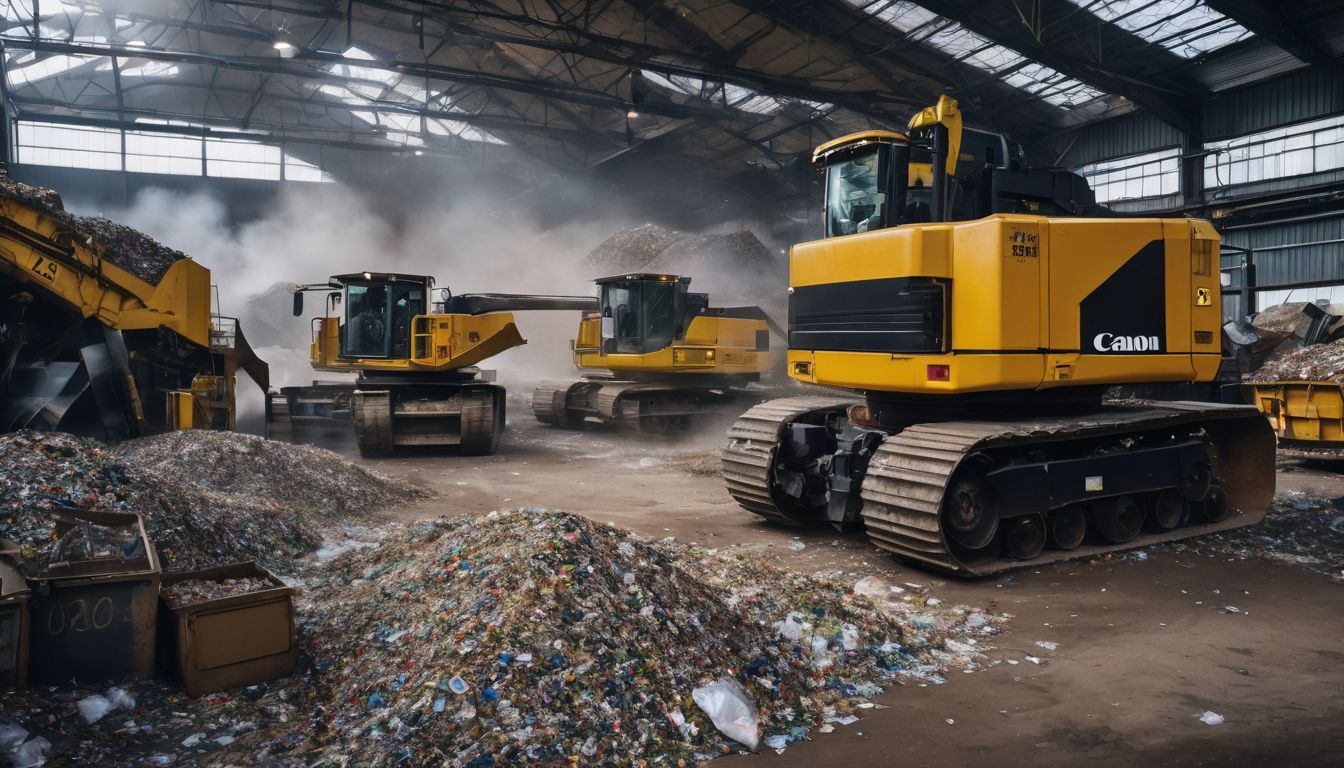In a world full of gadgets, we all face the dilemma of what to do with our old electronics. Every year, millions of tonnes of electronic waste are generated globally. This article will guide you through safe and sustainable ways to recycle your electronic devices.
Let’s make a difference together!
Key Takeaways
- Recycling your electronics responsibly helps conserve natural resources and reduces the environmental damage caused by hazardous substances in e-waste.
- Certified recycling facilities ensure that precious metals and toxic chemicals in electronic devices are safely handled and recovered for future use.
- Reusing and refurbishing old electronics extends their lifespan, minimises waste, saves energy, and supports a sustainable circular economy.
- Awareness campaigns and education on responsible e – recycling play a key role in reducing the amount of electronic waste that ends up in landfills or is incinerated.
- Manufacturers have a responsibility to design eco-friendly products with longer lifespans, support take-back programmes for end-of-life products, and promote repair over replacement.
Understanding E-Waste and Its Management
E-waste, or electronic waste, refers to discarded electrical or electronic devices. Proper management of e-waste is crucial due to its hazardous components and potential environmental impact.
The e-waste management cycle involves collection, recycling, and disposal of these electronics in an environmentally responsible manner.
Characteristics of e-waste
Electronic devices become e-waste as soon as they are discarded, which happens often because technology rapidly becomes outdated. This waste includes a mix of materials: precious metals such as gold and silver; hazardous substances like lead, mercury, and cadmium; and various plastics that can release toxins if not handled correctly.
Each component requires special treatment to ensure safe disposal and recycling, making the process complex but essential for environmental protection.
E-waste carries significant value due to recoverable resources within its composition. However, these valuable parts sit alongside dangerous chemicals that threaten soil health when improperly disposed of in landfills or burned in incinerators.
To manage these risks effectively while reclaiming useful elements, it’s crucial we understand proper e-waste management practices. Moving forward, let’s explore why managing electronic waste responsibly is so important for both our planet and our communities.
Importance of proper e-waste management
Proper e-waste management is crucial for safeguarding the environment and public health. Electronic devices contain hazardous materials that can pose serious risks if not disposed of responsibly.
Implementing eco-friendly disposal methods ensures the reduction of electronic waste’s environmental impact, encouraging a sustainable circular economy and minimising the release of harmful substances into the ecosystem.
Responsible e-waste management also promotes resource conservation by recycling valuable materials found in electronics, thereby supporting environmentally conscious individuals’ efforts to protect our planet.
E-waste management cycle
The e-waste management cycle involves several important steps to ensure responsible e-waste disposal and recycling. It begins with the collection of electronic devices that have reached the end of their lifecycle, either due to damage or obsolescence. These devices are then sorted based on their potential for reuse, refurbishment or recycling.
Sustainable Methods for E-Waste Disposal
To ensure a safe and sustainable disposal of electronic waste, it is important to consider reusing and refurbishing electronics, recycling electronic components, participating in responsible e-waste collection programs, implementing legislation and regulations, as well as raising awareness and educating others about the importance of proper e-waste management.
These methods contribute to reducing the environmental impact of electronic waste.
Reusing and refurbishing electronics
Reuse and refurbish electronics to extend their usable life and reduce electronic waste.
- Extend the life of your devices by repairing or upgrading them instead of replacing.
- Consider donating or selling old but functional electronics to minimise waste.
- Invest in refurbished electronics as a sustainable alternative to buying new ones.
- Participate in e – waste collection programmes to ensure responsible disposal and potential refurbishment.
- Educate others about the benefits of reusing and refurbishing electronics to promote sustainable practices.
Recycling electronic components
- Recovering precious metals such as gold, silver, and copper from circuit boards and other components reduces the need for mining and lowers the environmental impact of metal extraction.
- Repurposing plastic casings and housings through recycling decreases the amount of plastic waste in landfills, contributing to a greener environment.
- Separating and reusing glass from monitors and screens not only reduces e – waste but also minimises energy consumption required for manufacturing new glass products.
- Extracting valuable materials like palladium and platinum from electronic catalysts promotes resource conservation and minimises the exploitation of natural resources.
- Recycling your electronic devices at certified e – waste recycling facilities ensures that toxic substances like lead, mercury, and cadmium are safely handled, preventing harm to human health and the environment.
- Proper recycling of electronic components supports sustainable practices, promoting a circular economy where materials are reused rather than discarded, thus reducing the overall negative impact on the environment.
Responsible e-waste collection programs
Responsible e-waste collection programmes play a crucial role in diverting electronic devices from landfills and ensuring their safe disposal. These programmes are designed to gather used electronics, such as smartphones, computers, and tablets, for proper recycling or refurbishment.
- Collection drives and drop-off centres: Organised events and designated locations where individuals can deposit their old electronics for recycling.
- Partnership with retailers: Collaboration with electronic stores or manufacturers to provide convenient collection points for old gadgets.
- Mail-in programmes: Services that allow people to mail their electronic devices to specialised facilities for safe recycling.
- Local government initiatives: Programmes run by municipal authorities to collect e-waste from homes or businesses for responsible disposal.
- Awareness campaigns: Efforts aimed at educating the public about the importance of disposing of e-waste responsibly and encouraging participation in collection programmes.
Implementation of legislation and regulations
Transitioning from responsible e-waste collection programmes, implementing legislation and regulations is crucial for effective management of electronic waste. It ensures that there are clear guidelines in place to govern the proper disposal and recycling of electronics. This helps in creating a framework for environmentally conscious individuals to support conservation efforts and minimise the impact of e-waste on the environment.
- Legislation and Regulations: Governments worldwide have implemented laws and regulations to control the disposal of electronic waste, ensuring that it is managed safely and responsibly.
- Extended Producer Responsibility (EPR): EPR laws hold manufacturers responsible for the end-of-life management of their products, encouraging them to design more sustainable devices and take responsibility for proper disposal.
- Waste Electrical and Electronic Equipment (WEEE) Directives: These directives set collection, recycling, and recovery targets for electronic waste, promoting the safe disposal of electronics while minimising their environmental impact.
- Restriction of Hazardous Substances (RoHS) Directive: RoHS restricts the use of hazardous materials in electronics manufacturing, reducing the potential harm to human health and the environment when these devices reach their end-of-life stage.
- International Agreements: International agreements like the Basel Convention aim to regulate transboundary movements of hazardous wastes, preventing developing countries from becoming dumping grounds for e-waste from developed nations.
- Incentives and Penalties: Governments may provide incentives for companies that implement sustainable e-waste management practices while imposing penalties on those who do not comply with regulations.
- Public Awareness Campaigns: Authorities conduct campaigns to educate individuals about their roles in proper e-waste disposal as part of legislative efforts to protect the environment.
Awareness and education
Awareness and education are crucial in promoting responsible e-waste management. Educating yourself and others about the impact of electronic waste on the environment is important for making informed decisions. Here are some ways to increase awareness and educate others:
- Hosting workshops or seminars to discuss the environmental impact of e – waste and sustainable disposal methods, using keywords like “environmental impact of ewaste” and “electronic waste management”.
- Collaborating with local schools or community groups to incorporate e – waste education into their curriculum, highlighting “responsible ewaste recycling” and “safe disposal of electronic devices“.
- Utilising social media platforms to share informational posts, videos, and infographics on the importance of responsible e-waste management, using hashtags such as “#ewasterecyclingathome” and “#sustainablerecyclingmethods”.
- Organising outreach events to provide practical demonstrations on how to properly recycle or repurpose electronic devices, emphasising “eco-friendly disposal options” and “proper ewaste disposal methods”.
- Establishing partnerships with businesses and organisations to promote eco-friendly practices and raise awareness about the benefits of sustainable e-waste management, including “responsible ewaste management” and “sustainable disposal of ewaste”.
Alternative Methods for E-Waste Disposal
Some alternative methods for e-waste disposal include landfilling and incineration, but these methods can have harmful environmental impacts. It’s important to explore sustainable options for electronic waste management.
Landfilling
Landfilling electronic waste can lead to hazardous materials leaching into the soil and groundwater, posing significant environmental and health risks. E-waste contains toxic substances such as lead, mercury, and cadmium, which can contaminate the surrounding environment if not properly managed.
Improper disposal of electronics in landfills also contributes to greenhouse gas emissions, further impacting the planet’s delicate ecosystem.
Instead of sending electronic devices to landfills, it’s important to consider more sustainable options such as recycling or responsible e-waste collection programmes. By choosing eco-friendly disposal methods for electronic waste, we can significantly reduce the environmental impact and protect our planet for future generations.
Acid bath
Acid bath involves the use of strong acids to dissolve and extract valuable metals from electronic waste. This process is highly hazardous due to the release of toxic fumes and the potential for groundwater contamination, posing significant environmental and health risks.
Although it can recover certain materials, acid bath is not a sustainable method for e-waste disposal, as its negative impact on ecosystems and human communities far outweighs any potential benefits.
Incineration
Incineration
Incineration involves burning electronic waste at high temperatures. This process can reduce the volume of e-waste significantly, but it also releases harmful chemicals into the air.
These emissions contribute to air pollution and pose health risks to both humans and the environment. Incineration may not be the most environmentally friendly method for disposing of electronic waste, as it does not address the issue of resource recovery or recycling.
Therefore, responsible e-waste management focuses on sustainable methods that prioritise resource conservation and environmental protection.
Advantages and Disadvantages of E-Waste Technology and Management
Advantages of e-waste technology include the recovery of valuable materials and reduction in environmental pollution, while disadvantages include the potential for improper handling leading to health and environmental risks.
Read on to learn more about sustainable e-waste disposal methods.
Advantages
Opting for responsible e-waste management and recycling electronic devices brings about several benefits. Firstly, it helps in conserving natural resources by reducing the need for raw materials used to manufacture new electronics.
This contributes to minimising environmental impact and lowering energy consumption during production. Furthermore, sustainable e-waste disposal also aids in preventing the release of harmful chemicals into the environment, safeguarding human health and ecosystems.
Moreover, proper handling of electronic waste promotes job creation through the refurbishing and recycling processes, contributing to a more sustainable economy.
Disadvantages
Electronic waste disposal also has its fair share of challenges. Improper handling and disposal of e-waste can lead to environmental pollution, as well as health risks for those involved in the recycling process.
Additionally, there is a lack of awareness around responsible e-waste management, leading to an accumulation of electronic waste in landfills or incineration facilities. Furthermore, some electronic devices contain hazardous materials such as lead and mercury that can leach into the environment if not properly managed.
Moving on from the disadvantages of e-waste management, let’s explore effective ways to reduce electronic waste in our everyday lives.
Ways to Reduce E-Waste
Donating or selling usable devices, opting for repair over replacement, and choosing electronics with longer lifespans are all effective ways to reduce e-waste. Read on to learn more about sustainable methods for recycling electronic devices.
Donation or selling of usable devices
Consider donating or selling your usable electronic devices, such as phones, tablets, and laptops. Many organisations accept donations of working electronics for reuse by those in need.
By doing so, you extend the lifespan of these items and reduce the demand for new products. Selling your devices through reputable channels not only provides someone else with a budget-friendly option but also minimises e-waste generation.
In this way, you actively contribute to sustainable e-waste management while potentially earning some extra cash.
Opting for repair over replacement
When electronic devices malfunction, opting for repair over replacement can significantly reduce e-waste. Repairing electronics extends their lifespan and reduces the demand for new products, minimising environmental impact.
By choosing repair services or DIY fixes, individuals contribute to the sustainable management of electronic waste.
Choosing repair over replacement promotes responsible e-waste recycling while conserving natural resources. It aligns with eco-friendly disposal options and supports environmentally conscious practices, ensuring safe disposal of electronic gadgets.
Choosing electronics with longer lifespans
Opt for electronics designed with durable materials and high-quality components, ensuring a longer product lifespan. Prioritise devices from manufacturers committed to sustainability and eco-friendly production processes, reducing the environmental impact of electronic waste.
Look for energy-efficient models with upgradeable features, encouraging longevity and adaptability over time. Evaluate products with extended warranties and reliable customer support services for prolonged usage and efficient repairs when necessary.
When considering new electronic purchases, focus on long-term usability while minimising the need for frequent replacements or upgrades. By choosing electronics with longer lifespans, individuals can actively contribute to reducing e-waste accumulation, aligning their choices with sustainable consumption practices.
Practicing safe e-recycling
When recycling electronic devices, it’s essential to find reputable e-recycling facilities near you. Look for certified electronics recyclers who adhere to responsible e-waste management practices.
Ensure that personal data is securely erased from the device before disposal, protecting your privacy and preventing identity theft. Seek out e-waste recycling programmes or events in your community, allowing you to safely dispose of old electronic gadgets while reducing environmental impact.
By being mindful of proper e-recycling methods and choosing environmentally friendly disposal options, you can contribute to minimising electronic waste and promoting sustainable ewaste management.
Corporate responsibility in e-waste reduction
Manufacturers play a crucial role in reducing e-waste by designing products that are durable and easy to repair. Companies can also take responsibility for the end-of-life management of their devices, implementing take-back programmes and promoting responsible recycling.
Furthermore, businesses should strive to use sustainable materials in their electronic products and reduce packaging waste through eco-friendly design practices.
To minimise electronic waste generation, companies can also invest in research and development to create innovative technologies with longer lifespans and upgrade capabilities. This kind of corporate responsibility not only benefits the environment but also encourages consumers to make more sustainable choices when it comes to electronics.
Alternative options such as Reel Paper.
Consider Reel Paper as an alternative option for reducing e-waste. This eco-friendly choice provides sustainable paper products made from bamboo, which grows rapidly and does not require replanting after harvest.
Using Reel Paper reduces the demand for traditional wood pulp, thereby helping to preserve forests and prevent deforestation. Additionally, choosing Reel Paper supports responsible e-waste management by offering a renewable and biodegradable alternative to electronic devices.
Opting for Reel Paper presents an opportunity to make a positive impact on the environment through everyday choices. By selecting this sustainable option, individuals can contribute to the reduction of electronic waste while also supporting conservation efforts and promoting eco-friendly practices in their daily lives.
Conclusion
In conclusion, sustainable recycling methods for electronic waste are essential for environmental protection. Responsible e-waste management and eco-friendly disposal options have a significant impact on reducing the environmental footprint of electronic devices.
Embracing safe and sustainable practices for ewaste disposal is crucial for preserving our planet’s well-being and conserving valuable resources. Taking proactive steps to recycle electronics responsibly at home or through proper channels contributes to a healthier environment for future generations.
FAQs
1. What are sustainable recycling methods for electronics?
Sustainable recycling methods involve ecofriendly disposal options and responsible e-waste management to reduce the environmental impact of electronic waste.
2. Can I recycle my electronic devices at home?
Yes, you can participate in e-waste recycling at home by finding local programs that offer environmentally friendly e-waste disposal services for your electronic gadgets.
3. Why is it important to properly dispose of electronics?
Proper ewaste disposal methods help prevent harmful chemicals from damaging the environment, making it a crucial part of ecofriendly electronic waste management.
4. How does responsibly recycling electronics affect the environment?
Responsible ewaste recycling reduces pollution and conserves resources, significantly lowering the negative impact of recycling electronic devices on our planet.
5. What are some strategies for reducing e-waste?
Ewaste reduction strategies include reusing or donating functional gadgets and opting for safe disposal of electronic devices when they reach their end-of-life.





